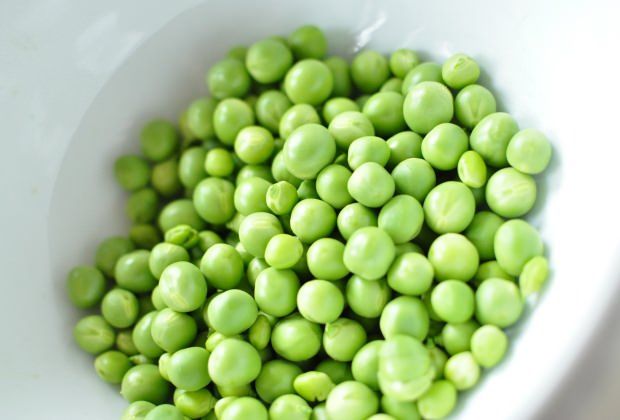
Goldfish need vegetables in their diet.
Without the leafy greens they crave, goldfish can develop nutritional deficiencies down the road. If you continued to give your goldfish just protein snacks, they’d become sick and lethargic, even flipping upside down.
Fancy goldfish especially are known for their swimming problems.
These fish have bulky bodies and tightly packed organs. Because of the distorted arrangement of their swim bladder and digestive tract, fancy goldfish aren’t strangers to constipation. If you have a floating-sensitive fish, your goldfish would appreciate more fiber, pre-soaked dry pellets, and a varied diet.
What better way to give your fish the nutrients they need than by feeding goldfish peas?
Why Feed Green Peas to Goldfish?
Two reasons.
- Unlike this vegetable, green peas sink when placed under water. Sinking goldfish food is especially important for sensitive fish because they won’t have to search for food at the water surface… and suck in air bubbles while they’re at it.
- Green peas are especially rich in fiber. According to this article, one cup of peas contains 7 grams of dietary fiber. That’s more than broccoli (2.4 grams), lettuce (1 gram), and spinach (0.7 of a gram) combined.
Fiber helps goldfish prevent constipation (and other known symptoms of swim bladder problems).
You might feed your goldfish a stable diet of dry and freeze-dried food, but without fiber from fresh vegetables, your goldfish might develop a blockage in the digestive tract. This blockage can cause your goldfish to lose equilibrium, have difficulty swimming, and even swim upside down!
Prevent Constipation By Feeding Goldfish Peas
Many goldfish hobbyists believe that green peas help push trapped air and food blockages from the digestive tract.
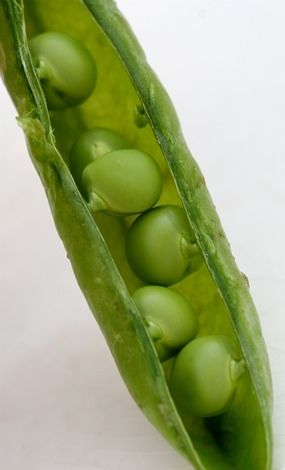
The fact remains that without enough fiber, your goldfish will not be able to release waste after a feeding. This waste buildup can cause serious harm.
Goldfish are ravenous eaters and often poop out buckets. Without enough fiber to help bowel movements along, waste that your goldfish are constantly developing will get stuck and put pressure on the swim bladder (source). This pressure will prevent the swim bladder from inflating and deflating as it should. This causes goldfish to swim erratically.
Fancy goldfish with egg-shaped bodies are especially sensitive to swim bladder problems because of how their internal organs are positioned in the body. Often these organs are compressed to make up for their round body shape. The slightest blockage can put pressure on the swim bladder and prevent fancy goldfish from swimming properly.
At the same time, too much fiber will prevent your goldfish from absorbing important nutrients into the body (source), so it’s best to find a balance.
Fresh peas are very high in fiber, so they’re particularly effective for treating constipation (over other vegetables).
Feeding goldfish peas occasionally can prevent constipation, but don’t overdo it. We’ll talk about how many peas to feed (and when) later in this article.
While fresh peas can solve some floating problems, feeding goldfish peas won’t heal genetic swim bladder disease or permanently damaged swim bladders. Peas also won’t cure bacterial infections that may cause swim bladder problems. Feeding goldfish peas will only treat floating problems related to constipation.
Feeding Peas to Goldfish: A Step-By-Step Guide
Constipation can easily be prevented with a quality nutritional diet.
In this section we’ll take a look at how many peas to feed and how to prepare fresh peas before feeding time, including a step-by-step guide on feeding goldfish peas.
How Many Peas and How Often to Feed?
You know what they say…
A green pea a day week keeps the doctor away.
Green peas work great as a preventative against constipation, treatment for constipation, or nutritious snack. But you don’t want to go overboard. Too many peas will prevent your goldfish from absorbing some important nutrients they need to stay healthy.
If you’re…
- Treating constipation: Feed your goldfish a sole diet of peas daily for 3 days. If your fish are still constipated, you can continue feeding goldfish peas for 2 more days. If peas don’t solve the problem after 5 days, it’s likely that your goldfish aren’t constipated (and are suffering from poor water quality, a bacterial infection, internal parasites, or permanent swim bladder damage). When feeding goldfish peas, only feed 2-3 peas per goldfish. Young goldfish can receive half this amount. After treatment, resume your goldfish’s regular diet (and go easy on the feeding from now on).
- Preventing constipation: Feed goldfish fresh peas once per week to keep fiber levels up. Also include fresh vegetables twice per week for a well-rounded diet. Vegetables should be fed to supplement your goldfish’s stable diet of dry food. Fancy goldfish sensitive to swim bladder problems may also benefit from one day of fasting every week. Feed 2-3 peas per adult goldfish. Half this amount for younger goldfish.
As with any food you give your goldfish, too much of a good nutrient can be harmful. Striking a balance is key for long-lasting goldfish that thrive.
But don’t worry. If you follow the recommendations in this guide, you shouldn’t run into problems.
Let’s walk through the steps.
Step 1: Buy Fresh Peas from the Store
There are several varieties of peas you can feed to your goldfish. Each kind has its own nutritional value.
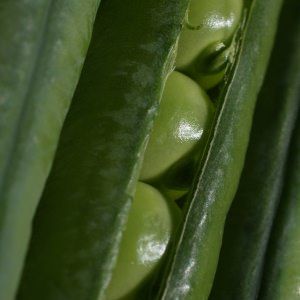
- Garden peas – Garden peas are the most common variety found in stores. They may need to be chopped up for younger goldfish to consume.
- Snow peas – Snow peas are also called sugar peas and are very sweet. They’re pretty small, so it’s a lot easier to break them into bite-sized chunks.
- Snap peas – Snap peas are also sweet, though they’re about the size of garden peas. Snap peas may need to be chopped before feeding.
- Frozen peas – Frozen peas are a great alternative to fresh vegetables. You’ll need to thaw them out or run them under hot water though.
- Split peas – Split peas are bought dried, peeled, and split into two halves. While split peas need to be soaked in hot water (step 2), you can skip step 3 and step 4 in this guide.
- Canned peas – Canned vegetables are very high in sodium. Unless you buy all natural canned peas without added preservatives, I wouldn’t recommend them.
Goldfish aren’t fussy. They could care less what kind of peas you give them. You don’t even have to buy them organic.
Don’t buy seasoned peas for your goldfish though. Spices will make your goldfish sick and could cause serious harm.
My personal favorite is frozen peas. They’re easy to keep, easy to prepare, and can stay in your freezer for several years.
Step 2: Soften Green Peas for Consumption
Before feeding goldfish peas, remove peas from the pod if you bought them attached.
Now let’s prepare the meal.
You can soften peas one of three ways.

- Rinse your peas off with warm water. This method works great for frozen peas. Simply rinse frozen peas off with warm water for 15 – 30 seconds. This will soften them just enough for your goldfish. You can then let the peas defrost on a plate or napkin (if you need more time) before commencing to step 3.
- Place fresh peas into the microwave. This is the fastest method to soften fresh peas. Take a microwave-safe bowl and fill it partly with water. Plop in the peas and microwave them on high for 30 – 60 seconds. Take the bowl out and place the peas on a plate to cool off. Wait a couple minutes, then move to step 3.
- Boil fresh peas on the stove top. This method may take longer but is the most effective. Fill a pot partly with water and let the water come to a boil. Drop fresh peas into the pot and reduce heat. Boil the peas for 1 minute before pouring them into a strainer to cool off. Alternatively, you can replace the hot water with cold water instead of using a strainer. Let the peas cool for a couple minutes before moving to step 3.
The trick here is not to soften the peas so much that they’re mushy but just enough so that your goldfish can digest them easily.
If softened just right, the peas should not cloud the water during feeding time.
Step 3: Remove the Skin before Feeding Goldfish Peas

The thin skin around green peas can make your goldfish choke. That is, if it doesn’t get stuck on the roof of the mouth first.
Remove the skin by either…
- Tearing off the skin: With your fingers, tear a small hole into the skin. This hole can then be used to peel off the remaining skin from the pea. Do this for every pea you plan to feed your goldfish. Discard the skin.
- Squeezing the skin: Pinch a corner of the skin and the weight of the pea should help it slide out smoothly. Be careful though; if the insides are too soft, your peas might turn to mush. Complete this process for each pea, then throw away the skin.
I personally like poking a small hole into the skin and then carefully unwrapping the skin from the vegetable. The pea will keep its shape this way. Then you can cut each pea into equal sections (step 4).
Step 4: Cut Fresh Peas into Two Halves
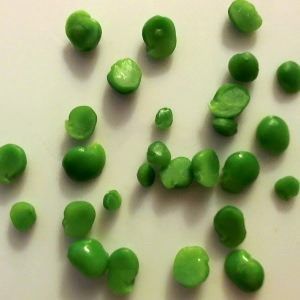
When you remove the skin from green peas, usually each pea will already be divided into two parts with (what would be) the stem of the seed curved along the center. Cut along this line so that each pea is separated into two halves.
You can now feed your goldfish immediately or make the food even easier to eat in step 5.
Sure, you can squish together both halves of the pea to condense it and make it smaller for feeding. But I find the process of feeding goldfish peas to be a lot cleaner if you instead take the time to cut each pea into bite-sized chunks.
Some fish enthusiasts like feeding goldfish peas the second the peas are removed from the skin. However, your goldfish might have a better time enjoying the meal if you cut them up first. Your goldfish will be able to eat fresh peas quickly and the food won’t hang from their mouths while they munch.
Step 5: Slice Each Pea into Smaller Chunks
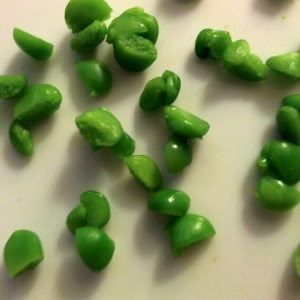
Do this especially for young goldfish that can’t fit a whole half of a pea in their mouths.
Cut every chunk (that you created in step 4) in half. Each pea should now be separated into 4 small chunks – a nice size to be easily digested.
I find that goldfish are able to eat these smaller chunks more easily than a whole pea. You can even further slice up each pea for smaller fish, though it may not be necessary.
Now you’re ready to feed the newly prepared meal to your goldfish!
Open the aquarium cover and sprinkle in a few chunks at a time. You should only feed 2 – 3 peas per adult goldfish (1 – 2 peas for younger fish).
An hour after feeding goldfish peas, check the substrate for uneaten food and remove them from the gravel (either with a siphon during a water change or a net).
Put leftover peas you didn’t feed into the freezer. You can defrost them and feed them to your goldfish next time.
Your Goldfish Aren’t Eating Peas?
Peas quickly sink to the substrate. If your goldfish have buoyancy problems, they likely won’t be able to get to the peas for feeding.
You can solve this problem by gently holding your goldfish and hand feeding.
Or, you can pick up a few clean toothpicks and push the opposite end of the pick through a whole pea or half a pea. Then hold the toothpick near your goldfish’s mouth for easy access. Make sure you don’t feed your goldfish with the sharp end – you don’t want to accidentally hurt your fish!
Live, frozen, or freeze-dried daphnia can be fed to your goldfish instead to treat constipation if you have daphnia on hand.
Remember: fiber-rich foods are only solutions for goldfish suffering from constipation. Damaged swim bladders are permanent (there isn’t a cure). Floating problems caused by bacteria, internal parasites, or poor water quality require their own special treatments (and can’t be treated by feeding goldfish peas).
Are You Feeding Goldfish Peas?
What types of peas do you feed? How do you prepare your peas for feeding? What other steps do you take before feeding goldfish peas? Have peas worked for you in the past?
What tricks do you use to cure constipation?
Share your experiences. Post tips or feedback in the comments below!



39 comments
Hi Christina,
I really appreciate your efforts and experience that has brought such great article into reality.
I am a newbie in this field and have just brought an aquarium home which contains fishes like Oranda, Mollies, Gouramis, Tank Cleaner Fish (I dont know his name, Sorry) and of course the Gold Fishes.
I am feeding them packed food like Optimum and Taiyo, but I want to feed them green peas and bananas as you have suggested.
The question that I would like to ask is as I have other species of fishes altogether… Would serving green peas and bananas be safe for other members of the tank except for Gold Fishes??? Or they tend to harm other species???
Please suggest and oblige.
Regards,
Neeraj Sinha
Hi Neeraj,
Green peas and bananas should be perfectly fine for your other tropical fish. While I don’t keep gouramis or mollies myself, I found several forums where people who do have fed both species of fish fresh fruits and vegetables with no problems.
You will want to go easy on the fruit though, since fruit does contain a lot of sugar. I’d recommend feeding chopped fruit once or twice per month as a special treat. I like to feed my goldfish fruit on birthdays (whatever day I first introduced them to my tank) or special holidays.
Veggies, on the other hand, are great to feed on a weekly basis – especially fancy goldfish with constipation issues!
The frozen peas work great for my goldfish but as soon as I start him on his food again the swimbladder problem returns. He’s happy on the peas but he can’t have them instead of food can he? Any advice is appreciated please, thanks.
Hi Kim,
Happy to hear feeding goldfish peas has been working for you! Though, it’s never good if your goldfish is dependent on peas alone to remain upright!
What do you usually feed your goldfish? If you’re routinely feeding dry foods like pellets or flakes (I recommend sinking pellets over flakes for fancy varieties with swim bladder problems), it might help to soak the pellets in water for 5 – 10 seconds. Otherwise, the pellets could expand in the intestines and cause blockages that might be contributing to the buoyancy problems.
Try that and see if it helps. The swim bladder issue could also be caused by problems in the water. Have you tested the water for ammonia, nitrite, and nitrate recently? Make sure ammonia and nitrite stay at 0ppm (parts per million), and keep nitrate below 40ppm. If any of these water parameters are high, performing several water changes over the next few days might help fix the problem. You can read more about water testing here if you need help.
Stress from the environment can cause all kinds of goldfish issues, and your goldfish will be on a faster road to recovery when they’re not so stressed out.
Hi
I bought 4 fan tail gold fish this weekend. I have introduced them into 116 liter tank with internal filter. Am feeding pellets. Before feeding i soak into water and leave it for 5 minutes. Then i feed the fish, so the pellets doesn’t float. Should i include peas once in a week or feed peas only fish is having swimming blader problem.
You can feed peas weekly or other types of veggies once per week to ensure your goldfish always have enough fiber in their diet. While fresh peas are pretty high in fiber, carrots and broccoli can also be fed to improve fiber in the diet if you’re looking to add variety. I actually recommend weekly feedings of peas and always make sure my goldfish receives a nice helping of veggies every Saturday.
It’s good that you’re soaking your pellets before feeding. That definitely does help prevent swim bladder problems in fancy goldfish like fantails. But I’m worried that your aquarium might be a bit overcrowded. However, if you stay on top of your water changes and testing, 116 liters might be fine. I do recommend considering at least 151 liters though – but, again, if you can keep water conditions healthy, it may not be necessary (though it can be a bit more work to do so in an overcrowded tank).
I tried lettuce last night, is it better to chop the lettuce up or use a veggie clip? And also, my goldfish is samson the destroyer, beautiful fish really, and how can you prepare other veggies for samsons consumption? his a fancy
Hi Nick,
I always use a veggie clip with no problems. I do break up the lettuce a bit, just to make it easier for the goldfish to tear apart.
You’ll want to boil veggies until they’re soft enough to tear easily. Besides peas, your goldfish will probably like broccoli, lettuce, zucchini, and carrots (some people feed squash as well). I like to feed veggies once per week to supplement their main diet. But don’t be afraid to experiment with different types of veggies to see what your goldfish like most. Just stay away from canned food – too much sodium!
When I threw the peas in he didn’t eat them but I want to try again I don’t know if he likes them or not
Hi John,
Sometimes it may take time for your goldfish to get used to food he hasn’t had before – your goldfish may not even know what you’re giving him is food until he’s had a bite!
I remember when I first introduced lettuce into the aquarium. My goldfish didn’t even know what to do with it at first! But eventually they started snacking on it – or maybe “attacking” is the right word. 😉 So it may take some time for your goldfish to catch on.
I’d give it a few days. You could even try feeding your goldfish a couple pellets just so he’ll know that it IS feeding time. Maybe that will get him to try the peas? Just remember to remove any uneaten peas so they rot in the tank.
HI, green peas make my goldfish swim upside down and have a lot of problems swimming and keeping his balance, this happens as soon as the goldfish eats the peas . What could be the reason and what should I do?
Hi Alireza,
That’s odd. Green peas shouldn’t cause your goldfish to swim upside down. Do you think you might be overfeeding?
How often do you generally feed your goldfish? Once or twice per day? More often? Also, how many peas do you usually feed per feeding session? Do you also remove the skin from the peas before feeding, and are you cutting each pea up into bite-sized chunks?
If the peas aren’t helping swim bladder problems, I recommend fasting your goldfish for three days and let me know if that helps. While your goldfish are fasting, test the aquarium water to make ensure ammonia, nitrite, and nitrate levels are where they should be. Remember, ammonia and nitrite should always be at 0ppm (parts per million) in an established tank, while nitrate should be kept below 40ppm. If you need help with this, you can read more about water testing in my water parameter guide here.
If either of these three parameters are higher than the recommendations above – especially ammonia or nitrite! – you have a water quality problem that’s most likely contributing to the swim bladder issue. Immediately perform a partial water change – how much water you change out will depend on how badly your water parameters have gotten out of hand. While you’re removing water, it might help to do a gravel sweep with your water siphon or gravel vacuum to catch any uneaten food that may be rotting in the substrate. From here on out, you’ll want to perform a partial water change every day until ammonia, nitrite, and nitrate are back at healthy levels again.
But definitely try fasting your goldfish for at least three days and test those water conditions! Let me know if you need any more help. If the fasting does solve the problem, you may just be overfeeding and will need to limit how often or how much you feed your goldfish on a daily basis.
Hi Christina,
My fish has had SBD for a week. He’s floating on his side near the surface. His mouth and gills are below the surface and they are constantly opening and closing, almost as if he’s lacking in oxygen. He also won’t eat – I’ve tried feeding him both peas and normal fish food and he just spits them back out. I’m really worried, do you have any suggestions?
Hi Remi – how’s the water? Did you test for ammonia and nitrite? Did you add any new fish to the aquarium recently without quarantining first? It’s hard to really determine the cause of the problem without more information. Since your goldfish is clearly not constipated, my best guess would be either a bacterial or parasitic infection.
If you didn’t add any new fish or plants in the last couple months (and there’s no clear outward signs of parasites), it might be bacterial. Of course, some parasites are not clearly visible (gill flukes and internal parasites like tapeworms, for example). Does your goldfish look very thin (thinner than usual)? That could be a sign of an internal parasite infection (transparent white fecal waste can also indicate internal parasites) – a medication containing praziquantel is really effective for this (and extremely gentle on your fish). I’ve had great results with PraziPro (and if your goldfish does have tapeworm, you can usually see the dead parasites leave the body on the second day after treatment).
Something like gill flukes can be a little bit harder to treat – mostly because the medication won’t affect the eggs flukes leave. So, after you thought your aquarium was “successfully” treated for flukes, any leftover eggs can hatch and cause another fluke outbreak. If you noticed your goldfish scratching on objects before he got sick and started floating on his side, there’s a good chance your goldfish may have flukes if there’s no other symptoms of external parasites. I’d use something like Paraguard, which can be a gentler alternative to some formalin-based medications. It also treats some bacterial and fungal infections (and if your goldfish does in fact have external parasites, he could very well get secondary bacterial or fungal infections on the wounds the parasites leave behind).
But don’t just pick up any medication hoping it will make your goldfish feel better without knowing exactly what disease your goldfish is suffering from. There’s a chance your goldfish may not have parasites at all and instead may have a bacterial infection. Or, if there’s high levels of ammonia in the tank, your goldfish could be suffering from ammonia poisoning (or nitrite poisoning if there are high nitrites). That’s why I suggest to test the water first before you buy anything. If either ammonia or nitrite are above 0ppm, you’ll want to change 30-50% of the water daily until levels go back to 0. You can read more about water testing in my guide here.
Your goldfish will have a better chance of recovery in healthy, clean water!